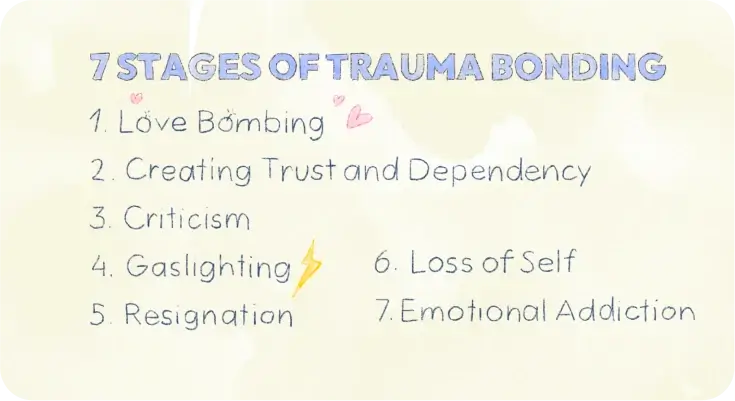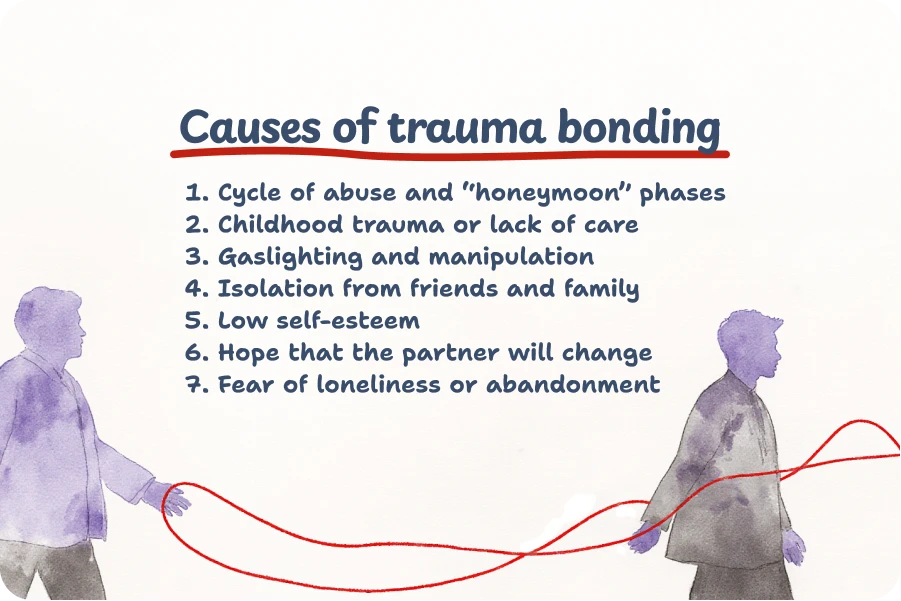If your relationship felt like an emotional rollercoaster with intense highs followed by painful lows, you may have experienced trauma bonding. This type of emotional attachment can be incredibly difficult to break free from, as those who have been abused often feel a strong sense of loyalty and dependence toward their abuser.
Let’s explore the seven stages of trauma bonding and how to recognize and escape from these abusive relationships.
What Is Trauma Bonding?
Trauma bonding is a strong emotional connection that forms between an abuser and their victim. This bond is formed through a cycle of abuse, devaluation, and positive reinforcement. When a partner constantly changes their attitude from sudden cruelty to praise and adoration, and vice versa, this is an example of the cycle of abuse.
Trauma bonding is characterized by feelings of loyalty, empathy, and even love towards the abuser despite the presence of abusive behavior, manipulation, and mistreatment. This connection can negatively affect mental health, destroy a person’s self-esteem, and lead to prolonged depression.
In 1997, addiction therapist Patrick Carnes first used the term “trauma bond.” In his article “Traumatic Bonds: Why People Attach to Those Who Hurt Them,” he explains that this term, “dysfunctional attachment that occurs in the presence of danger, shame, or exploitation,” is a manifestation of how our minds respond to trauma [1].
Expert Insight
At the same time, ending the relationship can trigger immense fear and emotional discomfort.
Nicole Arzt
Mental health professional
Typically, trauma bonding is prevalent in various types of abusive and toxic relationships, including intimate partner abuse, child emotional abuse, and cult involvement.
Still, it is a kind of survival mechanism that sometimes helps the abused person reconcile the abuse, looking for comfort and approval from them. Someone who experienced abuse may even defend the abusive person and downplay the gravity of the mistreatment due to the intensity of this connection.
Wondering whether you experienced parental bonding in your childhood? Take an insightful test to find out!
7 Stages of Trauma Bonding
Let’s take a closer look at the stages of the trauma bonding cycle:
Stage 1: Love bombing
The first stage of trauma bonding is love bombing. This is also called “the honeymoon phase.” Here, your partner is showering you with affection, gifts, and compliments. They’re putting you on a pedestal, and it feels fantastic.
You also might feel like you’ve finally found your soulmate, someone who understands you completely. The reason is that abusers often use love bombing to “hook” their partner and keep them under control.
Stage 2: Trust and dependency
As you get more invested in the relationship, you may start to rely on your partner more and more. You might trust them implicitly, even when things start to feel a bit off.
What’s more, you may start neglecting other relationships or activities in favor of spending time with your partner. This stage is all about building a strong emotional connection, but it can also be a way for your partner to isolate you from your network.
Stage 3: Criticism
This is where things start to take a turn. Your partner may initiate a pattern of criticizing you, which can diminish your sense of self-worth. You could start to doubt yourself and feel like you can’t do anything right.
Your partner may nitpick your appearance, your behavior, or your choices. They may also start to withdraw affection or give you the silent treatment when you don’t meet their expectations.

Stage 4: Gaslighting
Next, an abusive partner can start playing ‘mind games’ to make you question your own reality. They deny things you know happened or twist situations to make you feel like something is wrong with you.
You may start to feel like you’re losing your mind, and your partner may use this confusion to exert further control over you. Gaslighting is an example of a manipulation tactic that can leave you doubting your own perceptions and intuition.
Stage 5: Resigning to control
At this point, you feel worn down. You may start to give in to your partner’s demands just to keep the peace. You may walk on eggshells, trying to anticipate your partner’s moods and needs. Such behavior can take on a form of learned helplessness.
You lose sight of your own needs and desires, focusing solely on pleasing your partner. This stage can be especially dangerous, as it can lead to a complete loss of autonomy and make you feel worthless.
Stage 6: Loss of self
You’ve been so focused on pleasing your partner and avoiding conflict that you’ve lost touch with who you are. This stage can be incredibly isolating and depressing, as you feel like you’ve lost yourself completely.
Stage 7: Emotional addiction
Despite the pain and chaos, you might find yourself craving your partner’s attention and affection. You’re hooked on the highs of the good times, even though the lows are devastating.
You may also feel like you can’t live without your partner, even though these abusive relationships are destroying you. This addiction can be both psychological and physiological, as your body becomes accustomed to the highs and lows of the trauma bonding cycle. The idea of losing your partner may feel far more frightening than maintaining the status quo.
10 Signs You May Have Trauma Bonding
- You feel a strong attachment to your partner despite the presence of strong signs of emotional abuse or mistreatment in this relationship
- You make excuses for your partner’s hurtful behavior
- You also minimize its impact on yourself
- You might feel guilty even over small things you may have done
- You experience intense highs and lows in the relationship, with moments of affection overshadowing the abuse
- You feel sad or mad for no reason, as you might think
- You feel overly emotional sometimes, wondering, “Why do I get attached so easily?”
- You feel a sense of loyalty or protectiveness towards your partner, who practices abusive behavior
- Over time, in trauma-bonded relationships, you start asking yourself, “Why do I hate myself?”
- You struggle with the idea of leaving the relationship, even when you recognize its negative impact on your mental well-being
Looking for more quizzes to spot psychological abuse in romantic relationships or recognize your recurring behavioral patterns? In the Breeze app, you can find tests on your personality, attachment style, emotional intelligence, and much more.
Causes of Trauma Bond
A trauma bond is formed when one person intermittently provides affection, attention, or validation to the other, creating a trauma bonding cycle of highs and lows. The inconsistent reinforcement strengthens the attachment, making it difficult for the person to leave the relationship, even when it’s harmful.
According to attachment theory, our style of attachment forms in childhood [2]. If you have experienced childhood trauma like neglect, loss, or domestic violence, it can make it harder to recognize and resist narcissistic abuse and other forms of abusive relationships later in adulthood.
We are social creatures, and people form bonds with each other to stay alive. Infants form attachments to the parents or caregivers they depend on, and adults form attachments to people who comfort or support them.
A trauma bond can form when an abused person’s primary caretaker also happens to be their abuser. In the same way, the abused person may seek solace in the abusive partner, even though they were the ones who inflicted the pain.
The biopsychological model interprets this as follows: those who have been abused may appear emotionally connected to the aggressor in order to effectively adapt to life-threatening situations by “calming” the perpetrator. This reaction to a life-threatening experience is also called the fawn trauma response.
The latest research on abusive relationships, which included nearly 1,000 respondents, found a pattern: women who experience violence in intimate relationships and have symptoms of PTSD may show increased sensitivity and attachment to their abusive partners [3]. Isolation and a lack of resources also play roles. Frequently, abusers isolate their partners from family and friends. Also, financial dependence or a lack of emotional support may increase their emotional dependency and make it more difficult for them to leave the situation.

The Impact of Trauma Bonding And The Trauma Bonding Cycle
Trauma bonding can have a profound and long-lasting impact on survivors of abuse. Some of the common effects include:
- Trauma bonding can make it incredibly challenging for survivors to leave their abusers, as the emotional attachment is so strong that it overwrites the rational understanding of the abuse.
- The internalization of the abuser’s negative messages can lead to a distorted sense of self, self-blame, and low self-esteem, making one wonder, “Why do I feel like a failure?”
- Survivors may feel attracted to partners who act in similar abusive ways because the trauma bond taught them to confuse abuse with love.
- After experiencing the betrayal trauma, emotional or physical abuse, survivors may struggle to trust others and form healthy relationships, fearing intimacy.
- The ongoing trauma of abuse can lead to the development of PTSD, with flashbacks, nightmares, hypervigilance, and emotional numbness.
7 Myths vs Facts About Trauma Bond
Here are the most common myths and the facts that reveal the truth behind trauma-bonded relationships:
Myth 1. “Trauma bonding only happens in romantic relationships”
In fact, trauma bonds can form in any relationship involving power, dependency, and cycles of harm, including parent–child, friendships, workplace dynamics, and even cults or high-control groups.
Myth 2. “Once the abuse stops, the trauma bond instantly breaks”
The bond can remain long after the relationship ends. It often requires a conscious healing process, boundary-setting, and trauma therapy to fully break the emotional attachment.
Myth 3. “If someone stays, it means they are weak or want the abuse”
Staying is often the result of psychological conditioning, fear, isolation, or financial dependence, not desire, according to 2025 research on trauma bonding survivors [4]. It’s a biological and psychological response to inconsistent reinforcement. Trauma bonds create emotional confusion that makes leaving extremely difficult.
Trauma bonding can happen to anyone. Strong, intelligent, empathetic people can be even more susceptible to trauma-bonded relationships because of their loyalty and capacity to forgive.
Myth 4. “A trauma bond is the same as Stockholm Syndrome”
Essentially, Stockholm Syndrome is a psychological response that can occur in hostage situations. It is named after a 1973 bank robbery in Stockholm, Sweden, where hostages developed positive feelings towards their captors. While both trauma bonding and Stockholm Syndrome involve the development of positive feelings in the context of abuse or captivity, there are several key differences:
- Nature of the relationship. Trauma bonding often occurs in intimate relationships, such as romantic partnerships or family, whereas Stockholm Syndrome typically involves strangers in a hostage situation.
- Duration. Trauma bonding develops over an extended period of time, often months or years, while Stockholm Syndrome can develop within a matter of days or weeks.
- Abuse cycle. Trauma bonding is reinforced by the cyclical nature of abuse, with intermittent periods of affection or remorse. In Stockholm Syndrome, positive feelings develop as a response to the captor’s actions, which may include small acts of kindness within the context of captivity.
Myth 5. “A trauma bond is the same as true love”
Typical characteristics of a trauma bond include:
- Trauma bonds often feel like an intense, all-consuming emotional connection that can be mistaken for love. The ‘good times’ can feel euphoric and reinforcing.
- In a trauma bond, the abuser’s behavior is inconsistent, alternating between affection and mistreatment, creating confusion and uncertainty.
- There is often a significant power imbalance in the relationship, with one person having control over the other. This can make it harder to leave an unhealthy relationship.
- People in trauma bonds may focus only on the good things about the relationship and deny or explain away the abuser’s actions.
- Despite the harmful nature of the relationship, the person in the trauma bond may find it incredibly difficult to leave. This may be due to various logistical, financial, and emotional reasons.
In contrast to a trauma bond, true love is a healthy and mostly characterized by mutual care, understanding, and the desire for each other’s well-being and growth.
Here are some of the green flags in a relationship:
- Both partners mostly respect each other’s boundaries, opinions, and individuality.
- Genuine love is characterized by consistent, reliable behavior, trust, and emotional availability.
- In a healthy relationship, both parties have an equal say and share power in decision-making.
- Love thrives on open, honest communication, where both partners feel safe to express their thoughts and feel their feelings.
- A loving relationship encourages personal growth and provides a supportive environment for both partners to be the best version of themselves.
4 Steps To Break a Trauma Bond
If you recognize stages of trauma bonding in your own relationship, here are the main steps to recover from narcissistic abuse or any type of abusive relationship:
1. Admit you were in an abusive relationship
The very first and most important step is to honestly admit to yourself: “This relationship is toxic. What’s happening to me is abuse.” Name things as they are: instead of saying “he’s hot-tempered,” say “My husband is yelling at me and insulting me”.
At this stage, journaling with Breeze can be especially helpful. Writing down incidents and reflecting on them from an outside perspective makes patterns clearer and helps prevent falling into denial.

2. Cut off contact
In most cases, the only way to break a traumatic relationship is to completely cut off all contact. Block numbers, social media, and avoid places where you might meet. Every contact carries the risk of relapse and falling back into the cycle, as the abuser may use manipulation tactics like threats or begging for forgiveness.
3. Get support
Reach out to friends, family, or specialized services like crisis centers for victims of violence or helplines:
- The National Domestic Violence Hotline: https://www.thehotline.org/
- RAINN (Rape, Abuse & Incest National Network): https://rainn.org/
Support groups where people share similar experiences are especially effective, as they reducу feelings of shame and loneliness. Working with a mental health specialist who understands trauma and codependent relationships can help you:
- Restore self-esteem and personal boundaries, and learn how to love yourself.
- Learn to recognize manipulation and healthy relationships.
- Survive the period of separation and change your life.
4. Focus on self-care
To rediscover yourself beyond this relationship, reconnect with your hobbies, interests, and goals. Mindfulness practices like meditation, breathing, and grounding techniques help reduce anxiety and get back in touch with your feelings and needs.
There can be days when it hurts, and you’ll miss your partner. Try to remind yourself that these are the remnants of past trauma, not true love. Personalized Breeze affirmations can help you shift negative thoughts. For example:
- “I deserve happiness and fulfillment in every area of my life.”
- “I am not responsible for others’ actions or feelings.”
- “I honor my emotions and allow myself to feel fully.”

Frequently asked questions
1. How is trauma bonding different from a healthy attachment?
Healthy attachments are based on trust, respect, and mutual care. Trauma bonds form through fear, guilt, manipulation, and intermittent reinforcement, making the relationship feel addictive rather than supportive.
2. Who is vulnerable to trauma bonding?
Anyone can develop a trauma bond, but people with low self-esteem, a history of abuse, or strong empathy may be more susceptible. Abusers often target emotional needs to create dependency.
3. How to break trauma bonds?
Sources
- Patrick J. Carnes, Ph.D., CAS. Trauma Bonds.
- Inge Bretherton. The Origins of Attachment Theory: John Bowlby and Mary Ainsworth.
- Yael Lahav. Hyper-Sensitivity to the Perpetrator and the Likelihood of Returning to Abusive Relationships. 2023
- Robert Kaiser. The Psychology of Trauma Bonding – Why Survivors Remain Attached to an Abusive Partner. November 2025
Disclaimer
This article is for general informative and self-discovery purposes only. It should not replace expert guidance from professionals.
Any action you take in response to the information in this article, whether directly or indirectly, is solely your responsibility and is done at your own risk. Breeze content team and its mental health experts disclaim any liability, loss, or risk, personal, professional, or otherwise, which may result from the use and/or application of any content.
Always consult your doctor or other certified health practitioner with any medical questions or concerns
Breeze articles exclusively cite trusted sources, such as academic research institutions and medical associations, including research and studies from PubMed, ResearchGate, or similar databases. Examine our subject-matter editors and editorial process to see how we verify facts and maintain the accuracy, reliability, and trustworthiness of our material.
Was this article helpful?






